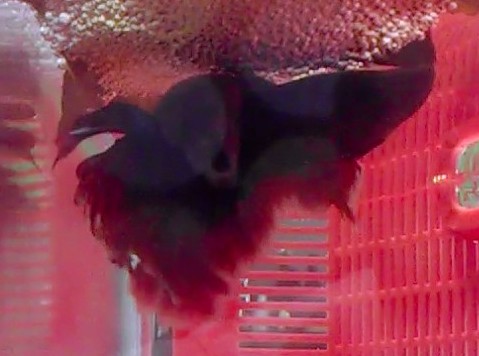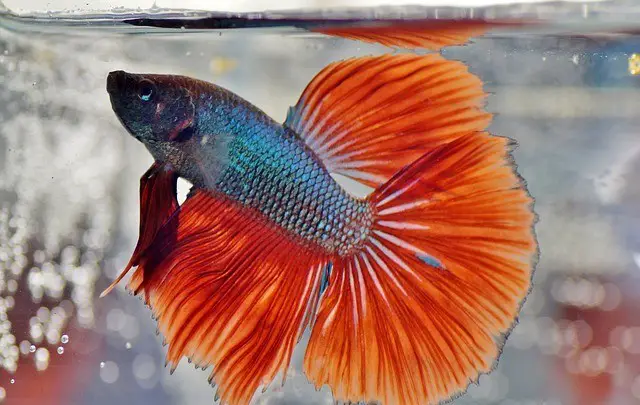Last Updated on 4 weeks by admin
How Betta fish mate?

Betta fish, also sometimes known as the Siamese fighting fish, is well-known for their aggressive nature and their tendency to defend their territory.
However, betta fish have a really interesting mating phenomenon.
When a male betta fish meets a female betta fish, they begin by doing what appears to be their natural habit- fighting.
After a while, when the male betta fish knows that the female betta fish has eggs, the fighting will eventually stop.
Both fish will come close and swim around each other, and occasionally they will show signs of shivering.
After brushing against each other and staying intimately close, the male betta fish will twist its body and wrap around the female fish, as if it wants to engulf the female fish. In fact, in this step, the male betta fish is trying to squeeze the female fish and at the same time, the male betta fish is trying to extract her eggs and fertilize them.
How does the egg look like?
Upon fertilizing, the female betta fish will release some white tiny eggs, which resemble the color and size of salt grains. The eggs will gradually fall from the female fish to the bottom of the tank, moving slowly down the water.
How long does mating take for betta fish?
Betta fish mating duration will vary from a few minutes to a few hours. It can be due to a lot of factors such as water temperature, surrounding etc.
How many eggs does female betta fish release? After mating, a female betta fish will typically release 30 to 40 eggs. However, some can lay up to 500 eggs.

Betta splendens
There are several signs that a betta is ready to mate, including a darker color tone and vertical stripes across the midsection. The female will also shed her eggs and build a bubble nest when ready to breed. Once the bettas are ready, they will swim side-by-side with their fins spread and stop to show off their sides. The male, however, will often chase her during this dance and she will quickly hide under moss to avoid him.
Another sign of a good Betta fish mate is an appearance. A betta may notice a ghostly invertebrate in a tank and try to investigate it. Ghost shrimp are not visible to the naked eye and are a great addition to any aquarium. These creatures are easy to care for and are inexpensive. They scavenge food and waste from the aquarium substrate. Ghost shrimp can grow up to 1.5 inches and live up to 1.5 years in the right tank. In addition, they love live plants and moss balls.
The process of betta fish mating is unique. Each fish has its own unique way of mating. The male Betta fish first builds a bubble nest, which varies in size and shape. He then approaches the female and wraps himself around her. During this process, the female releases up to 40 eggs per embrace. If the female betta is hungry, she will eat the eggs, but the male will not intentionally eat the eggs.
Wild betta fish
Betta fish in the wild mate to produce offspring. The male has flamboyant fins and a variety of primary colourations, while the female has a more subdued coloration and less flamboyance. When a male is looking to mate with a female, he will first build a bubble nest and then start a courtship display. Once he has captured a female’s attention, he will start embracing her. The female will then drop her eggs.
Male Bettas can be very aggressive when ready to mate. They can bite or chase a female if she is not interested. It’s best to keep several females together in order to increase your chances of securing an egg. Also, female Bettas prefer males with a red/orange pigment.
Female Betta fish are less aggressive than males, but can still show interest. They display their feelings for each other by flaring their fins and wagging their tail. They also produce a small amount of eggs, which look like grains of salt underneath their belly. The male betta is territorial and will even fight a female if she is in his territory.
Bettas in the wild are generally dull green and brown, with small fins. However, captive bettas have been bred to exhibit bright and vivid colors. Males are generally more colorful and more striking than females, and the fins have been altered to be longer and more slender. In addition, males have different tails from the wild Bettas.

Betta fish killing each other
If you have a Betta tank in your home, you have probably wondered how Betta fish kill each other. These fish are territorial, and when they fight, they will attack each other’s fins, causing injuries on their bodies. While some fights are over quickly, others can last up to an hour. Some fish even die during these fights, so it is important to understand how to prevent them.
Betta fish fight to establish territory, which may involve ramming another fish or biting its fins. These fish may also lock their lips together. Fighting is an important part of their ecosystem, and is common among many types of fish. If you notice a fight between two males, this could be a sign that the other fish is injured or is on the verge of dying.
In order to prevent this from happening, you should house your male and female betta fish in separate tanks. While the males are less aggressive, females are also known to attack each other. Since they are territorial, male bettas should never be kept together with females.
Betta fish life cycle
The Betta fish life cycle begins with the mating of a male and female fish. The male will usually first show no interest in the female, while the female will actively seek out the male. Once the male and female have been paired up, the female will lay her eggs on the male’s tail. He will then fertilise the eggs and move them to a bubble nest. Once the eggs are laid, the male will quickly grab them and place them in a bubble nest.
The eggs are laid in a bubble nest, which is created by the male. The male will guard the nest for about 50 hours to protect the eggs from predators. The egg-laying process usually lasts a few minutes, but in some cases, it can take hours. The male will take care of the eggs and the fry until they hatch.
Male betta fish will first defend his territory until he finds a mate. This is usually done through a bubble nest that he builds for his female companion. He will only show aggression towards the female once he is ready to mate, so the process is gentle.
Do betta fish attack other fish
Betta fish are territorial creatures. When they get into a territorial fight, they may ram, nip, or even lock their fins together. Fighting may also occur between males in a tank. While most bouts end in defeat, there are some instances where a fight continues until one male retreats. This behavior is normal for many species of fish. But, it can be dangerous.
Betta fish are a popular pet choice. They are not only popular with home aquarium owners, but are also used in scientific research and for competitions. Though they can survive in the water and breathe air, they cannot live in the same tank with other fish. If they do encounter another fish, they may attack them and kill them. If you’re concerned about the safety of your Betta fish, it’s best to keep your tank completely separate from other fish.
If you have two male bettas, it’s probably best to separate them from each other. This is because the male will fight their female companions, and will also attack their spawn. If you have a community tank, however, you should try not to keep both male and female betta fish together.
Betta fish fight
There are a few ways to help your Betta fish fight back. One way is to flare their gills and make them appear bigger, a technique many land species use to protect themselves. The other way is to nip at their opponents. This can cause a lot of damage to both the fish and the other. However, Betta fish fights rarely last more than a few seconds, so it is usually safe to use this method only once.
Betta fish are territorial creatures, and they need plenty of territory in which to roam. Their tank should have a capacity of about 15-20 gallons, and it should be balanced with other fighting fish. The ideal number of fighting fish in a tank is three to five, with no more than two females. The two females should not be housed together, however, if the females are aggressive. The tanks should also have a hiding area. For this purpose, you can add rocks or pebbles.
In the wild, Betta fish will fight each other until one retreats. This fight may last for several minutes, or longer if they’re bred. When it’s over, one fish will probably be dead or severely injured. If you’re thinking about getting a betta, remember that you’ll need to take proper care of your fish.
Siamese fighting fish
Siamese fighting fish are renowned for their beautiful reproductive behaviors. During courtship, male Siamese fighting fish blow mucus-coated bubbles for hours. The male then chases the female under a bubble nest. It’s beautiful to watch, but the male can be very violent when the female is unresponsive or unwilling to mate. In some cases, male Siamese fighting fish may tear the female’s scales.
While Siamese fighting fish can be bred in an aquarium, it is recommended to separate the male from the female to prevent in-fighting. It is not safe to keep two males in a single tank without a partition; they will fight until only one survives. The best option is to have two or three females in a tank.
Bettas are small, colorful fish native to Southeast Asia. They are commonly bred as pet fish. The Thai call them pla kat, which means “fighting fish.” Male bettas are well-known fighters and can flare their fins to attack their rivals. These fights can last fifteen minutes or more, but some breeders have even bred bettas that fight for hours.
Male bettas
When male betta fish meet a female, they may become aggressive and start biting each other. However, they will only mate with the female if she carries eggs. The male betta will entice the female to the bubble nest and then he will fertilize the eggs. The male will then place the eggs carefully into the bubble nest.
The process of attracting a mate begins when both the male and the female have been conditioned to swim towards each other. The female will move inward and the male will follow, attempting to wrap his body around her. The male will try different angles until they find the sweet spot. Once they reach the sweet spot, the female will release her eggs while the male fertilizes them.
When introducing a betta pair to each other, it is best to wait until both fish are in their second or third year of life. If you do decide to breed a male and a female, make sure to choose the brightest, most active male. It is also important to remember to select a female that is slightly smaller than the male. She should also have smooth fins.
Betta fish kill
Unlike many species of fish, bettas rarely kill one another, and fights usually end with the less dominant betta backing off and disappearing from view. Fighting is more likely to occur in captivity, where bettas have been genetically bred to be aggressive. Fighting is also a more stressful experience for both fish, making them vulnerable to infections and illnesses. Therefore, it is important to separate aggressive bettas before they become too large or dangerous.
Once you bring your betta home, it’s impossible to tell how healthy they are. They’re often sold as older fish, which means that their health may not be as good as it could be. It’s vital to research betta health before buying a new one.
While male bettas are naturally aggressive, they may be unable to tell the difference between a female and a threat. Consequently, male and female bettas often fight each other. Often, this leads to a death or exhaustion of the female, as well as disease in the male. For this reason, male and female bettas should only live together for short periods and be separated after mating.
Male betta fish fight
Male betta fish fight when they want to mate. These fish enlarge their fins, puff out their gills, and nip at each other until one of them backs off. These fights may last for several minutes or even an hour. They are often very painful and usually result in one of the fishes dying. It’s important to remember that fighting your bettas is an extremely stressful and potentially deadly activity, so it’s a good idea to separate them.
If you don’t want to risk your Bettas’ lives, try keeping two or more of them in separate tanks. If possible, place one in a tank divider. Another option is to add live plants, wood debris, or rock caves to the aquarium. Adding these can give your bettas plenty of hiding places and lessen the chances of a fight.
When male betta fish fight, they may ram one another or swim directly into each other. They may also bite one another’s fins or lock lips together. These actions may be indicative of territorial behavior, which is common among many species of fish.
What will the male and female betta fish do after mating?
After successful mating, the female fish will leave, or usually be removed from the tank.
On the other hand, the male betta fish will retrieve the eggs with its mouth and place them in a safe nest of bubbles, which it has created with its saliva before mating.
As long as the eggs have not hatched, the male fish will act as a protector of the eggs and it will guard the offspring from threats and other fish.
After approximately 50 hours, the eggs will hatch and offspring is successfully reproduced.
How does male betta fish form the bubble nest?
Male betta fish will form an egg nest using its saliva before mating with female betta fish. This is to ensure the safety and successful hatchery of the eggs.
The bubble nest will float on the surface of the water and this will keep the eggs off the bottom of the tank, to minimize chances of threats and dangers.
Also, male betta fish has a chemical in his saliva which can help the eggs to hatch and release the baby fish from the eggs.
Since betta fish are aggressive and hostile, why wouldn’t they fight with each other and kill each other during mating?
In advanced of the mating, male and female betta fish will have some light physical fight with each other. However, as evolutionary purpose suggests, they will soon notice that they are both ready to reproduce, and they will come to a halt.
The male fish will notice that the female fish is carrying eggs, and they will start to engage in mating behavior.
This is to ensure that their species can be reproduced successfully. However, after mating, male and female fish shall be separated. The male fish shall be separated from the baby fish as well after hatchery.
Why should the male and female betta fish be separated after mating?
This is because the male betta fish will resume to its aggressive nature, and will fight with the female fish to defend its territory, although they have just mated. In the case when they are not separated, a weak female betta fish will be killed by the male betta fish in the fight.
Why should the male betta fish be separated from the babies after hatchery?
As mentioned, the innate aggressive nature in male betta fish will drive it to confront the baby fish. Baby fish will eventually grow bigger, and the male betta fish will view this as a threat to its life and territory. Therefore, the male betta fish will fight the baby fish, or even eat the baby fish away.
Sources :
https://www.quora.com/How-do-Betta-fish-mate
https://www.brainstuffshow.com/blogs/how-do-betta-fish-mate-if-they-always-fight-with-each-other.htm
https://www.youtube.com/results?search_query=betta+fish+bubble https://www.fishkeepingworld.com/breeding-betta-fish/#Hatching_Eggs


